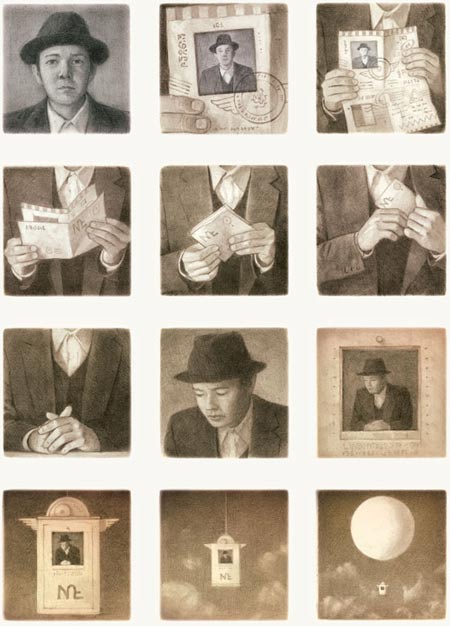 To mark the 10th anniversary of the children’s laureateship, the current holder of the post, Michael Rosen, and his four predecessors - Michael Morpurgo, Jacqueline Wilson, Quentin Blake and Anne Fine - this week selected their favourite children’s books. They were allowed seven choices each (you can read their lists here) and each chose some of my own favourite children's reads, ranging from The Box of Delights (Quentin Blake) to The Wolves of Willoughby Chase (Anne Fine) to The Railway Children (Jacqueline Wilson). I was particularly pleased to see that Michael Morpurgo even opted for a deeply unfashionable Blyton amongst his selection - the particularly fine Five Go to Smuggler’s Top.
To mark the 10th anniversary of the children’s laureateship, the current holder of the post, Michael Rosen, and his four predecessors - Michael Morpurgo, Jacqueline Wilson, Quentin Blake and Anne Fine - this week selected their favourite children’s books. They were allowed seven choices each (you can read their lists here) and each chose some of my own favourite children's reads, ranging from The Box of Delights (Quentin Blake) to The Wolves of Willoughby Chase (Anne Fine) to The Railway Children (Jacqueline Wilson). I was particularly pleased to see that Michael Morpurgo even opted for a deeply unfashionable Blyton amongst his selection - the particularly fine Five Go to Smuggler’s Top.However, what I did notice about the laureates’ choices is that with a few notable exceptions, they mainly opted for the “classics” of children’s literature: well-known books that are already established as general favourites. To continue my recent “children’s books” theme, I thought it might be interesting to create my own list of favourites with a difference - a list of “forgotten” children’s books rapidly disappearing into the lands of obscurity, that are maybe not quite so universally well-known. Here are my seven "forgotten favourites:"
1. Mystery at Witchend by Malcolm Saville
Written in the 1940s, this is a good old fashioned adventure in which a group of children (plus loyal dog) thwart a wartime sabotage plot by dastardly German spies. It’s the first in the Lone Pine series, a more sophisticated take on the Famous Five in which the members of the Lone Pine Club, armed with little more than their bicycles, sandwiches and hand-drawn maps, solve mysteries taking in everything from counterfeiting to sheep-rustling in a variety of real locations. Writing into the 1970s, Saville attempted to “sex up” the later books adding criminals with (shock!) guns, and even a touch of romance for his teenage characters who by now had traded in their cotton frocks and shorts for jeans, but the books still manage to retain their carefree innocent feel.
2. The Swish of the Curtain by Pamela Brown
First published in 1941,The Swish of the Curtain is a sort of original Fame! - the story of a group of children who, bored during a long summer holiday, discover an abandoned chapel in their home town and decide to transform it into a theatre. As the Blue Door Theatre company, they quickly develop serious theatrical ambitions, in spite of the opposition of their parents. Written by Brown when she herself was just fourteen, the novel is peculiarly timeless: in spite of the archaic picture it presents of a genteel suburbia complete with a kindly Bishop (the children’s ally) and a cringe-inducing Women’s Institute headed up by the dreaded Mrs Potter-Smith (their arch-nemesis) it feels very contemporary in tone, perhaps simply because of its robust sense of humour.
3. Greenwitch by Susan Cooper
In spite of the recent movie version, Susan Cooper’s Arthurian-inspired fantasy series, the Dark is Rising sequence seems to be distinctly out of fashion at the moment, perhaps because of its slightly 1970s homespun Woodcraft Folk-ish feel. The best known of the series is the second - the brilliant, and extremely scary The Dark is Rising - but my personal favourite is the third book, which focuses more on Cooper’s main female character, Jane. Set in Cornwall, it’s a classic seaside children’s adventure story but given a darker fantasy twist, haunted by the powerful mythical figure of the Greenwitch herself. The final section inevitably leads to what Nancy Mitford refers to as “Brimming”.
4. We Didn’t Mean to Go to Sea by Arthur Ransome
Surprisingly, Ransome’s famous Swallows and Amazons didn’t make it into any of the laureate’s selections, even though it’s an undoubted children’s classic. For my money though, We Didn’t Mean to Go to Sea is even better: the story of what happens when the Walker children’s holiday plans go wrong, and they find themselves unexpectedly fighting a storm in the treacherous waters of the North Sea, drifting away from the safety of the English coast into the shipping lanes - and into a real adventure. Marking a definite change of pace from the rather annoying whimsy of Peter Duck or the slightly too try-hard comedy “hi-jinks” of The Picts and the Martyrs, this a compelling heart-in-your-mouth story of adventure on the high seas.
5. Fifteen by Beverley Cleary
Beverley Cleary is now best known as the creator of naughty Ramona and her long-suffering older sister Beezus, but she also wrote Fifteen, a 1950s take on the “young adult novel.” It evokes an innocent, All-American world of high school dating, which already seems distinctly archaic: a lost realm of milkshakes, pin-curls and good manners. Gossip Girl it certainly isn’t, yet naive small-town heroine Jane faces all the familiar dilemmas of adolescence (how to decide what to wear to the dance; how to work out if Stan really likes her; how to deal with sophisticated, cashmere sweater- wearing Marcy), even managing to take in the unfamiliar exoticism of yes, a Chinese restaurant with characteristically gutsy good humour.
6. Clover by Susan Coolidge
I have to make a confession now: I still find all those old-fashioned “girls' books” - Little Women, Anne of Green Gables and the like - weirdly compelling reading. However my real favourites are the little-known “wild cards” of this genre: L.M. Montgomery’s Emily books, Louisa M. Alcott’s hilariously moralistic An Old Fashioned Girl, and especially one of the lesser-known sequels to What Katy Did, Susan Coolidge’s Clover. Leaving behind rather tiresome Katy (who, let’s be honest, since that whole thing with the swing has really become a bit of an annoying goody-two-shoes) this story focuses on younger sister Clover as she embarks on some much more exciting adventures Out West.
7. The Circus is Coming by Noel Streatfeild
Noel Streatfeild is perhaps most famous for the children’s classic Ballet Shoes, which won a place on Jacqueline Wilson’s shortlist. However, she also wrote many other novels, many of which are based around the theatre. The Circus is Coming marks a bit of a departure from the theme, being set in the world of (you guessed it) the circus. A bit less overtly girly than many of Streatfeild’s books, it tells of the adventures of prim and proper brother and sister Peter and Santa, who unexpectedly find themselves living with their estranged Uncle Gus, a circus acrobat, and become increasingly drawn into the world of the circus itself. (For any other serious Streatfeild fans out there, can I also alert you to her little-known autobiographial novel A Vicarage Family? Read it with a box of tissues close by, however. You too will be “Brimming”: I guarantee it.)


















